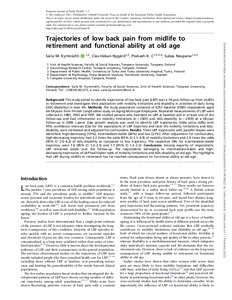Trajectories of low back pain from midlife to retirement and functional ability at old age
Kyrönlahti Saila M.; K.C. Prakash; Nygård Clas-Hågan; Neupane Subas
https://urn.fi/URN:NBN:fi-fe2022021519260
Tiivistelmä
Background
This study aimed to identify trajectories of low back pain (LBP) over a 16-year follow-up from midlife to retirement and investigate their association with mobility limitations and disability in activities of daily living (ADL-disability) in later life.
Methods
The study population consisted of 6257 baseline (1981) respondents aged 44–58 years from Finnish Longitudinal study on Aging Municipal Employees. Repeated measurements of LBP were collected in 1985, 1992 and 1997. We studied persons who had data on LBP at baseline and in at least one of the follow-ups and had information on mobility limitations (n = 2305) and ADL-disability (n = 2359) at a 28-year follow-up in 2009. Latent class growth analysis was used to identify LBP trajectories. Odds ratios (ORs) with 95% confidence intervals (CIs) for the associations of LBP trajectory and later life mobility limitations and ADL-disability were estimated and adjusted for confounders.
Results
Three LBP trajectories with parallel shapes were identified: high-decreasing (19%), intermediate-stable (60%) and low (21%). After adjustment for confounders, high-decreasing trajectory had 3.2 times the odds (95% CI 2.1–4.9) of mobility limitations and 2.9 times the odds (95% CI 2.0–4.2) of ADL-disability as compared to low trajectory. The respective ORs for intermediate-stable trajectory were 1.6 (95% CI 1.2–2.1) and 1.7 (95% CI 1.3–2.3).
Conclusions
Among majority of respondents, LBP remained stable over the follow-up. The respondents belonging to intermediate-stable and high-decreasing trajectories of LBP had higher odds of mobility limitations and ADL-disability at old age. This highlights that LBP during midlife to retirement has far-reached consequences on functional ability at old age.
Kokoelmat
- Rinnakkaistallenteet [19207]
